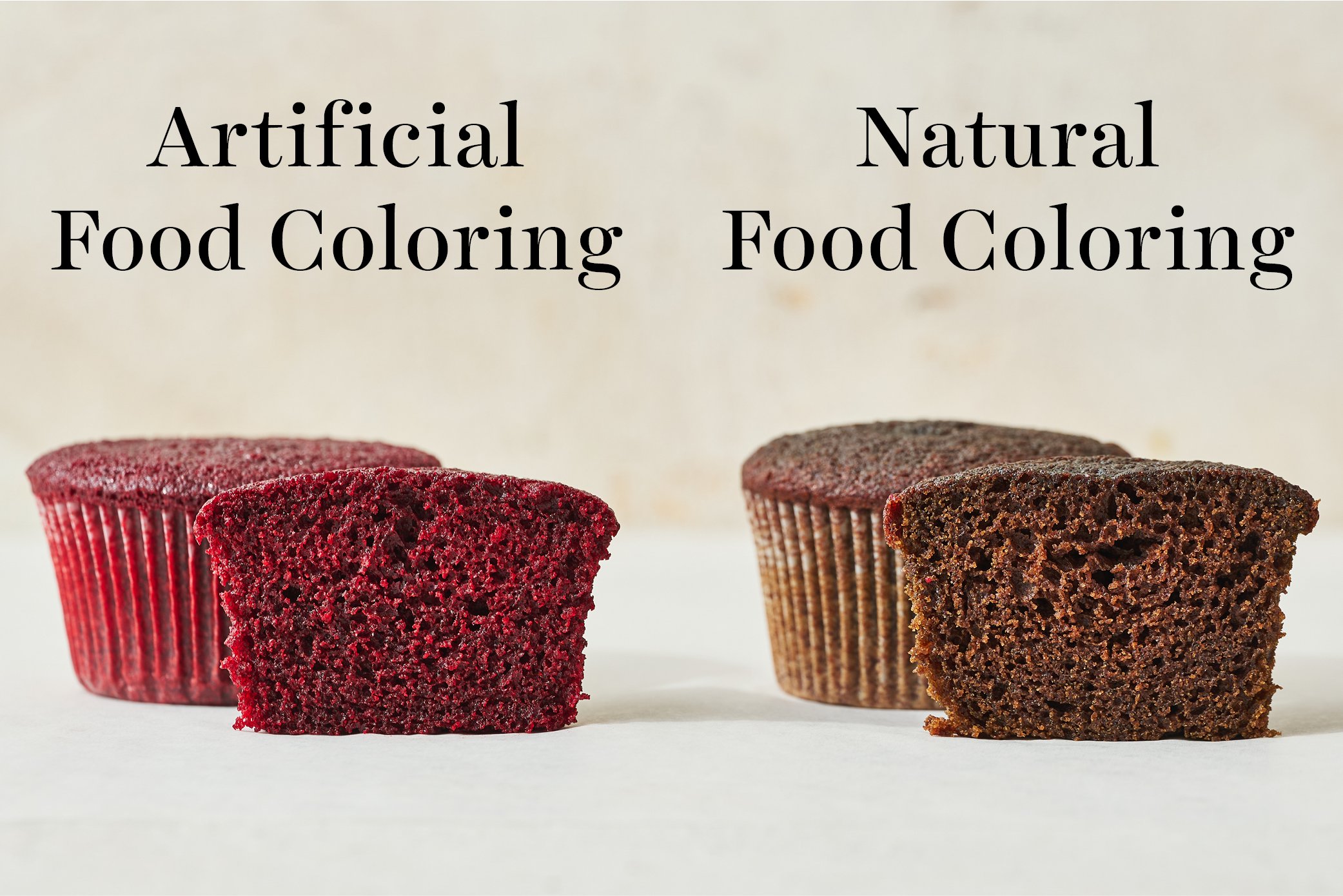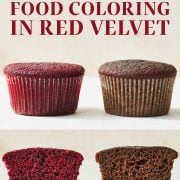This post may contain affiliate links. Read our disclosure policy.
When it comes to natural vs. artificial food coloring in baking, the choice between the two causes widespread debate.
In baking, the decision between natural and artificial colorings is determined by much more than perceived health benefits – and it’s more complex than simply switching out the type of dye used.
You all know I love a good side-by-side challenge, so we headed to the kitchen to determine how natural food coloring would perform in my Red Velvet Cupcakes!

I’m not sure who decided that Red Velvet had to be a vibrant red color, but traditionally, we add a decent dose of red gel food coloring to achieve that brightness and appeal. So when we decided to experiment with natural food coloring, I knew that red velvet was the perfect place to start.
Below, I go over some of the important information about both artificial and natural food colorings and then dive into the baking science involved in adapting a recipe to use natural coloring.
Note: We’re not here to debate the negative health issues potentially associated with artificial food coloring, of which there appears to be little to no conclusive evidence. We are simply determining if using a natural alternative can produce an equally bold color and delicious result in home baking.
Natural vs. Artificial Food Coloring
What is Artificial Food Coloring?
Artificial food coloring, also known as food dye, is typically made from a synthetic chemical designed specifically to add color to foods. Food dyes are used to boost appeal and attractiveness. Artificial coloring can be commonly found in candies and breakfast cereals, among countless other things. Home bakers use it to add festivity to frostings and various baked goods. These colors are predictable, stable, and stand up well to baking.
Some studies have claimed to show carcinogenic links and evidence of hyperactivity in children. The results of such studies have been inconclusive and inconsistent. There is evidence to suggest some people may have an allergic reaction to food dyes, though it is rare. Some countries have banned certain types of artificial food dyes. The U.S. has not yet imposed such bans though the government does regulate food colorants.
What is Natural Food Coloring?
Natural food colorings are derived from naturally occurring sources, like plants, animals, or minerals. These are used in place of artificial food dyes as they’re often perceived as healthier, safer alternatives (though that may not always be the case since many natural alternatives are less rigorously tested and regulated).

Converting a Recipe From Artificial to Natural Food Coloring
Issues with Using Natural Food Coloring in Place of Artificial Food Dye
Some issues arise when converting a recipe to use natural food coloring in place of an artificial dye:
- Color: Oftentimes, a great deal of natural coloring needs to be used to achieve a similar color – and the colors will often be less vibrant than using artificial dye.
- Unintended flavor: Many sources will recommend using ingredients like paprika, carrot powder, or turmeric to color your frosting or baked good – but who wants a paprika-flavored frosting? It can be difficult to mask these unintended flavors.
- Chemistry: This gets tricky. Some natural colors interact with recipe ingredients to give you colors that differ from what you expected. They can also have unintended textural consequences, such as cakes not rising, or rising too much.
- Stability: Some natural colors will change over time, increasing or decreasing in intensity as the coloring interacts with the other ingredients in your bake, especially when exposed to light, oxygen, or heat.

Using Beetroot Powder in Red Velvet Cupcakes
After much research on the best alternatives for red dye, we used Beetroot Powder in this Red Velvet Cupcake experiment. Many articles tout this as the best natural alternative. It can be difficult to source in stores, but it’s available online here.
What is Beetroot Powder?
Beetroot, aka beets, contain betanin, which is what gives them their distinctly bright color. Once the beets are peeled, sliced, and cooked, they are then dried and pulverized to create beetroot powder. As you may suspect, beetroot powder does carry some of that earthy beet flavor, so to help mask that earthy undertone, it’s important to only use beetroot powder in baked goods with other bold flavors.
Replacing Red Gel Food Coloring with Beetroot Powder
We discovered a lot of unexpected issues with switching the dyes that aren’t straightforward, both aesthetically and chemically.
- We needed to change the quantity of the food coloring. My standard recipe calls for 1 ½ teaspoons red gel food coloring, but that wasn’t nearly enough to color these cupcakes using natural food coloring. However, using too much altered the texture (because it’s a drying ingredient) and also gave the cupcakes a strong beet flavor.
- Leavening agents have some negative reactions with beetroot powder. My Red Velvet Cupcakes contain both baking powder and baking soda, which means you get a murky brown colored cupcake instead of a vibrant red. Some sites will recommend skipping the baking powder/baking soda completely – which is a terrible idea if you want an edible cake/cupcake! Learn more about why leavening agents are crucial to baking here.
- Acid. Beetroot powder can oxidize too fast and turn brown if there’s not enough acid in the recipe – but I wasn’t worried about that in my Red Velvet Cupcakes as they contain buttermilk and distilled white vinegar, so plenty of acid!


Experimenting with Artificial vs. Natural Food Coloring in Red Velvet Cupcakes
We took to the kitchen with my Red Velvet Cupcake recipe to determine how natural food coloring would alter the taste and texture of the baked cupcakes.
The Experiment
Alongside a batch of my original Red Velvet Cupcakes, we tested a batch of naturally-colored cupcakes.
- We added 3 tablespoons (30 grams) of beetroot powder to the dry ingredients, making no other alterations to the recipe.
- The cupcake batter had a dark pink coloring to it.
- The batter tasted like beets.
- Surprisingly, even with the additional 3T powder, the batter resulted in 11 ½ cupcakes! I assume the beetroot powder’s starch content absorbed some of the liquid, resulting in less batter.


Results: The Control Recipe
The Red Velvet Cupcakes using artificial red gel food coloring are moist and tender. The texture is beautiful and spongy, with a fine crumb. The flavor is perfectly sweet, with noticeable light chocolate and vanilla flavors.
Results: Red Velvet Cupcakes Using Natural Food Coloring
The Red Velvet Cupcakes using beetroot powder are light, crumbly, with a slightly coarse crumb, and a taller and slightly more domed appearance. The flavor is earthier and more muddied, with a noticeably less sweet finish. We didn’t love the earthy flavor, and the red color somewhat baked out, leaving these cupcakes with a fairly brown hue.


Conclusion
While it is possible to replace artificial food coloring with natural food coloring, the results won’t be as attractive and potentially not as pleasant to eat. You will also need to experiment with the recipe you’re using, as different ingredients will react differently to different natural colorings. It is possible to do, but you will need to play with your recipe a few times to get the flavor, texture, and appearance right.
If you’re looking to make Red Velvet Cupcakes that don’t contain artificial food coloring, I recommend simply skipping the red gel coloring in my Red Velvet Cupcakes, for cupcakes that will still be delicious and simply be a lighter brown color, rather than vibrant red.































My statements are purely my opinion, and others are welcome to have their own opinions! I won’t be offended if you disagree, and I hope you are not offended by my opinions. I don’t use food coloring because my children had TERRIBLE behavioral problems when they had it. It’s a chemical additive and their bodies really didn’t like it. That being said, I have tried “natural” food colorings a couple of times and they are not worth spending your money on. The colors look like mud, or the colors we wore in the 70s! HAHA. Just give me the real flavors and colors of food! The “grass” is colored with natural green food color. It’s not really green, but kind of a yucky yellow ochre.
I Totally agree with you also you cake looks great. The red velvet recipe that I use has grated beetroot in the mix, the cake is a rich deep red color unlike the artificial red of un natural food color. and very moist with the added benefits of actual beetroot.